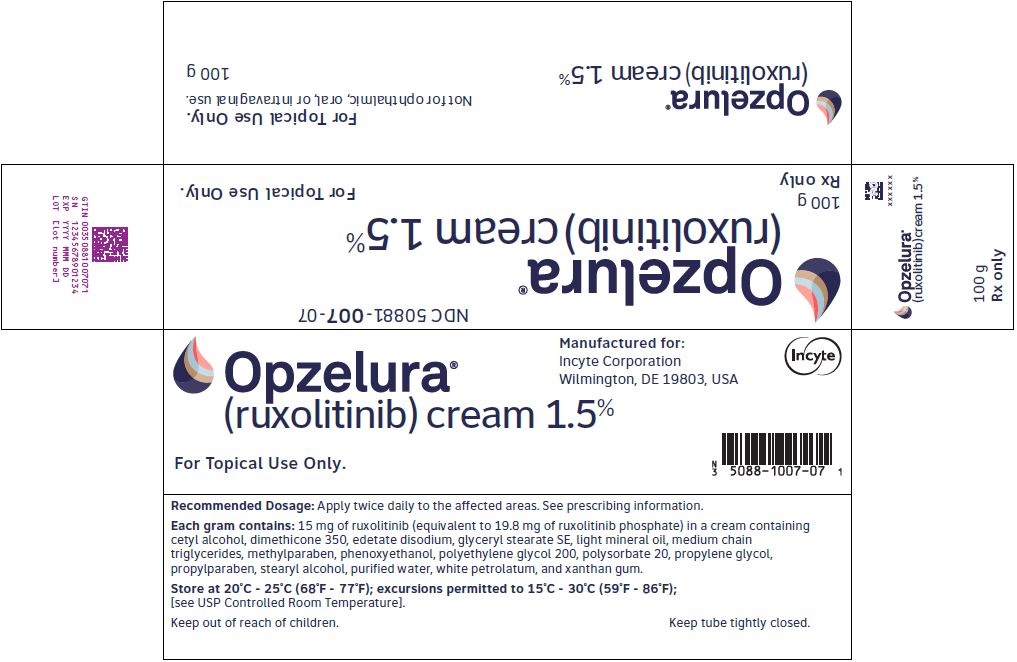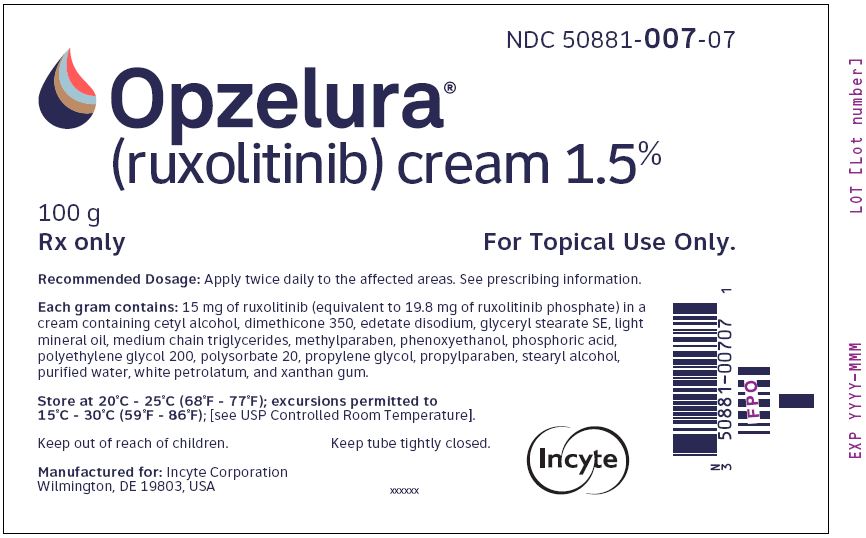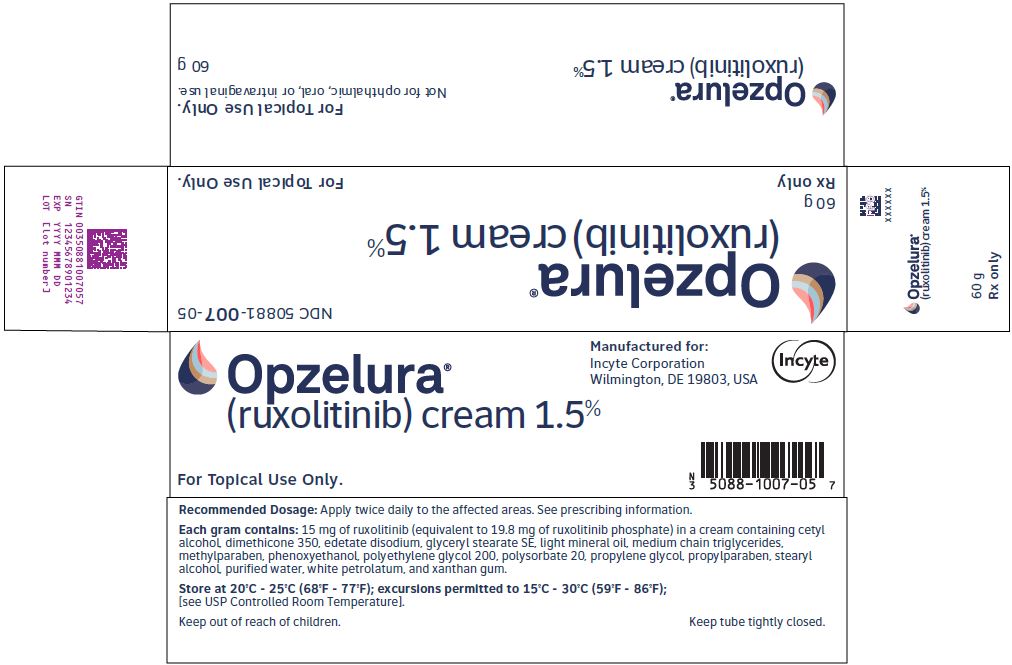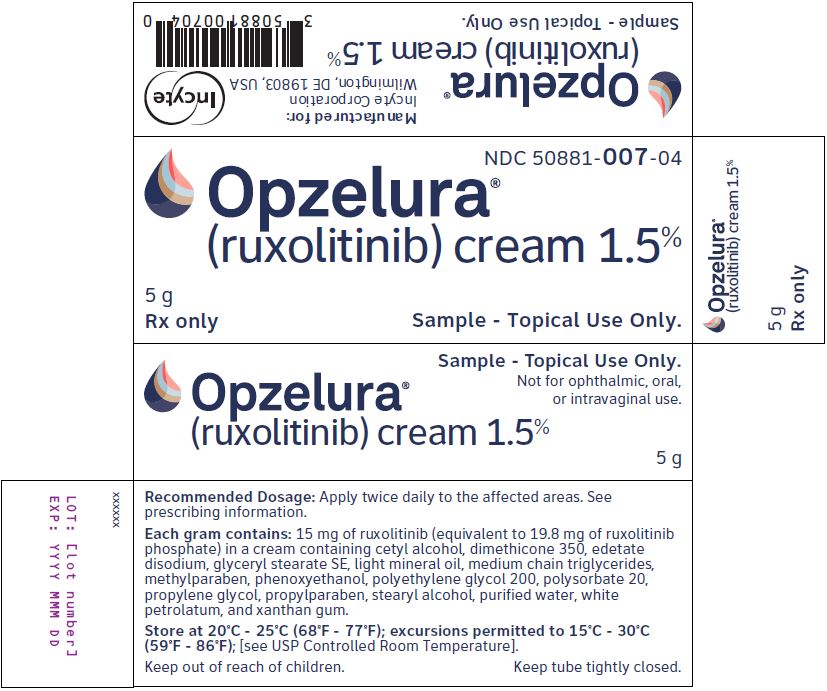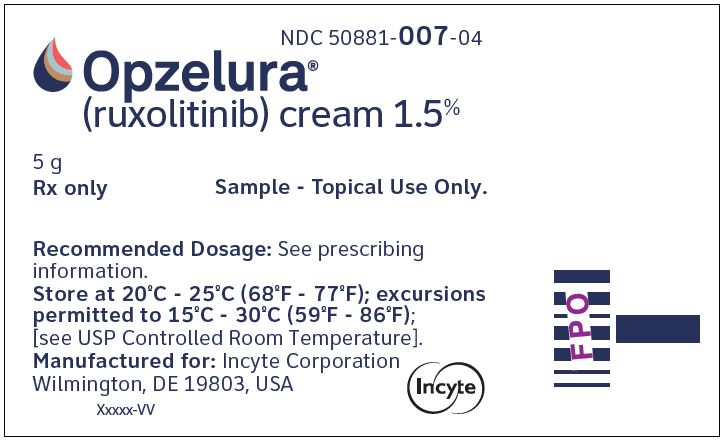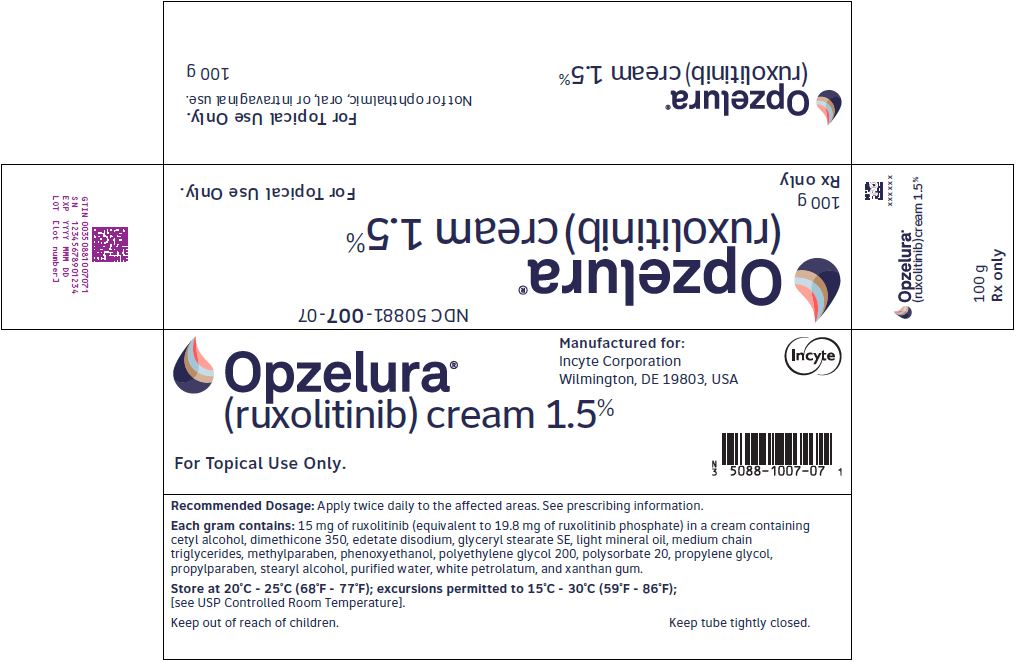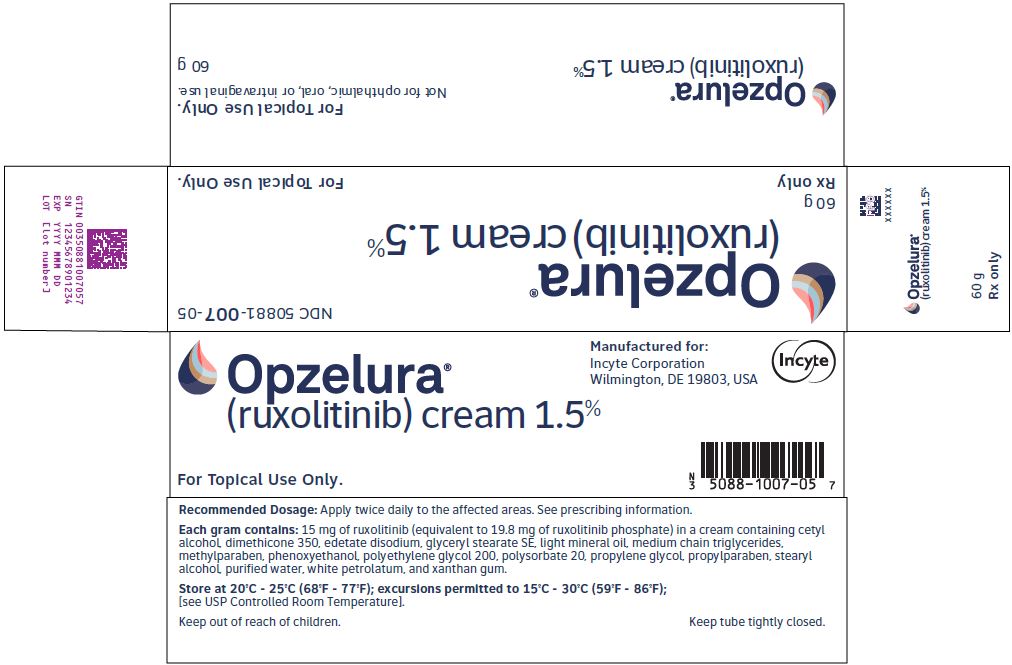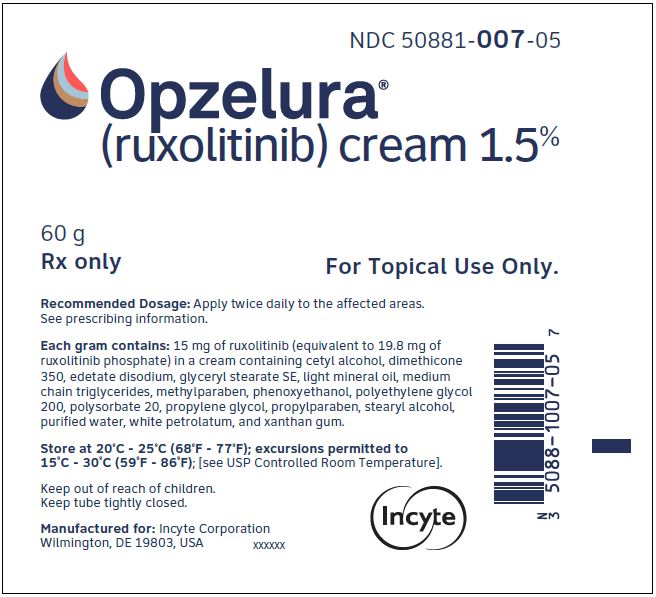Label: OPZELURA- ruxolitinib cream
- NDC Code(s): 50881-007-04, 50881-007-05, 50881-007-07
- Packager: Incyte Corporation
- Category: HUMAN PRESCRIPTION DRUG LABEL
- DEA Schedule: None
- Marketing Status: New Drug Application
Drug Label Information
Updated August 20, 2024
If you are a consumer or patient please visit this version.
- Download DRUG LABEL INFO: PDF XML
- Medication Guide: HTML
- Official Label (Printer Friendly)
-
HIGHLIGHTS OF PRESCRIBING INFORMATION
These highlights do not include all the information needed to use OPZELURA cream safely and effectively. See full prescribing information for OPZELURA cream.
OPZELURA® (ruxolitinib) cream, for topical use
Initial U.S. Approval: 2011
WARNING: SERIOUS INFECTIONS, MORTALITY, MALIGNANCY, MAJOR ADVERSE CARDIOVASCULAR EVENTS (MACE), AND THROMBOSIS
See full prescribing information for complete boxed warning.
- Serious infections leading to hospitalization or death, including tuberculosis and bacterial, invasive fungal, viral, and other opportunistic infections, have occurred in patients receiving Janus kinase inhibitors for inflammatory conditions. (5.1)
- Higher rate of all-cause mortality, including sudden cardiovascular death have been observed in patients treated with Janus kinase inhibitors for inflammatory conditions. (5.2)
- Lymphoma and other malignancies have been observed in patients treated with Janus kinase inhibitors for inflammatory conditions. (5.3)
- Higher rate of MACE (including cardiovascular death, myocardial infarction, and stroke) has been observed in patients treated with Janus kinase inhibitors for inflammatory conditions. (5.4)
- Thrombosis, including deep venous thrombosis, pulmonary embolism, and arterial thrombosis, some fatal, have occurred in patients treated with Janus kinase inhibitors for inflammatory conditions. (5.5)
INDICATIONS AND USAGE
OPZELURA is a Janus kinase (JAK) inhibitor indicated for:
- the topical short-term and non-continuous chronic treatment of mild to moderate atopic dermatitis in non-immunocompromised adult and pediatric patients 12 years of age and older whose disease is not adequately controlled with topical prescription therapies or when those therapies are not advisable. (1.1)
- the topical treatment of nonsegmental vitiligo in adult and pediatric patients 12 years of age and older. (1.2)
Limitations of Use
Use of OPZELURA in combination with therapeutic biologics, other JAK inhibitors or potent immunosuppressants such as azathioprine or cyclosporine is not recommended. (1.3)
DOSAGE AND ADMINISTRATION
- Do not use more than one 60 gram tube per week or one 100 gram tube per 2 weeks. (2.1)
- For topical use only. (2.1)
- Not for ophthalmic, oral, or intravaginal use. (2.1)
-
Atopic Dermatitis
- Apply a thin layer twice daily to affected areas of up to 20% body surface area. (2.2)
-
Nonsegmental Vitiligo
- Apply a thin layer twice daily to affected areas of up to 10% body surface area. (2.3)
DOSAGE FORMS AND STRENGTHS
Cream: 1.5% ruxolitinib (3)
CONTRAINDICATIONS
None. (4)
WARNINGS AND PRECAUTIONS
- Serious Infections: Serious bacterial, mycobacterial, fungal and viral infections have occurred. Regularly monitor patients for infection and manage it promptly. (5.1)
- Non-melanoma Skin Cancers. Basal cell and squamous cell carcinoma have occurred. Perform periodic skin examinations during treatment and following treatment as appropriate. (5.3)
- Thrombosis. Thromboembolic events have occurred. (5.5)
-
Thrombocytopenia, Anemia, and Neutropenia: Thrombocytopenia, anemia, and neutropenia have occurred. Perform CBC monitoring as clinically indicated. (5.6).
ADVERSE REACTIONS
- In atopic dermatitis, the most common adverse reactions (incidence ≥ 1%) are nasopharyngitis, diarrhea, bronchitis, ear infection, eosinophil count increased, urticaria, folliculitis, tonsillitis, and rhinorrhea. (6)
- In nonsegmental vitiligo, the most common adverse reactions (incidence ≥ 1%) are application site acne, application site pruritus, nasopharyngitis, headache, urinary tract infection, application site erythema, and pyrexia. (6)
To report SUSPECTED ADVERSE REACTIONS, contact Incyte Corporation at 1-855-463-3463 or FDA at 1-800-FDA-1088 or www.fda.gov/medwatch.
USE IN SPECIFIC POPULATIONS
-
Lactation: Advise not to breastfeed. (8.2)
See 17 for PATIENT COUNSELING INFORMATION and Medication Guide.
Revised: 8/2024
-
Table of Contents
FULL PRESCRIBING INFORMATION: CONTENTS*
WARNING: SERIOUS INFECTIONS, MORTALITY, MALIGNANCY, MAJOR ADVERSE CARDIOVASCULAR EVENTS, AND THROMBOSIS
1 INDICATIONS AND USAGE
1.1 Atopic Dermatitis
1.2 Nonsegmental Vitiligo
1.3 Limitations of Use
2 DOSAGE AND ADMINISTRATION
2.1 Important Administration Instructions
2.2 Recommended Dosage for Atopic Dermatitis
2.3 Recommended Dosage for Nonsegmental Vitiligo
3 DOSAGE FORMS AND STRENGTHS
4 CONTRAINDICATIONS
5 WARNINGS AND PRECAUTIONS
5.1 Serious Infections
5.2 Mortality
5.3 Malignancy and Lymphoproliferative Disorders
5.4 Major Adverse Cardiovascular Events (MACE)
5.5 Thrombosis
5.6 Thrombocytopenia, Anemia, and Neutropenia
5.7 Lipid Elevations
6 ADVERSE REACTIONS
6.1 Clinical Trials Experience
7 DRUG INTERACTIONS
8 USE IN SPECIFIC POPULATIONS
8.1 Pregnancy
8.2 Lactation
8.4 Pediatric Use
8.5 Geriatric Use
11 DESCRIPTION
12 CLINICAL PHARMACOLOGY
12.1 Mechanism of Action
12.2 Pharmacodynamics
12.3 Pharmacokinetics
13 NONCLINICAL TOXICOLOGY
13.1 Carcinogenesis, Mutagenesis, Impairment of Fertility
14 CLINICAL STUDIES
14.1 Atopic Dermatitis
14.2 Nonsegmental Vitiligo
16 HOW SUPPLIED/STORAGE AND HANDLING
17 PATIENT COUNSELING INFORMATION
- *
- Sections or subsections omitted from the full prescribing information are not listed.
-
BOXED WARNING
(What is this?)
WARNING: SERIOUS INFECTIONS, MORTALITY, MALIGNANCY, MAJOR ADVERSE CARDIOVASCULAR EVENTS, AND THROMBOSIS
SERIOUS INFECTIONS
Patients treated with oral Janus kinase inhibitors for inflammatory conditions are at risk for developing serious infections that may lead to hospitalization or death [see Warnings and Precautions (5.1) and Adverse Reactions (6.1)].Reported infections include:
- Active tuberculosis, which may present with pulmonary or extrapulmonary disease.
- Invasive fungal infections, including cryptococcosis, and pneumocystosis.
-
Bacterial, viral, including herpes zoster, and other infections due to opportunistic pathogens.
Avoid use of OPZELURA in patients with an active, serious infection, including localized infections. If a serious infection develops, interrupt OPZELURA until the infection is controlled.
The risks and benefits of treatment with OPZELURA should be carefully considered prior to initiating therapy in patients with chronic or recurrent infection.
Patients should be closely monitored for the development of signs and symptoms of infection during and after treatment with OPZELURA [see Warnings and Precautions (5.1)].
MORTALITY
In a large, randomized, postmarketing safety study in rheumatoid arthritis (RA) patients 50 years of age and older with at least one cardiovascular risk factor comparing an oral JAK inhibitor to tumor necrosis factor (TNF) blocker treatment, a higher rate of all-cause mortality, including sudden cardiovascular death, was observed with the JAK inhibitor [see Warnings and Precautions (5.2)].
MALIGNANCIES
Malignancies were reported in patients treated with OPZELURA. Lymphoma and other malignancies have been observed in patients receiving JAK inhibitors used to treat inflammatory conditions. In RA patients treated with an oral JAK inhibitor, a higher rate of malignancies (excluding non-melanoma skin cancer (NMSC)) was observed when compared with TNF blockers. Patients who are current or past smokers are at additional increased risk [see Warnings and Precautions (5.3)].
MAJOR ADVERSE CARDIOVASCULAR EVENTS (MACE)
In RA patients 50 years of age and older with at least one cardiovascular risk factor treated with an oral JAK inhibitor, a higher rate of major adverse cardiovascular events (MACE) (defined as cardiovascular death, myocardial infarction, and stroke), was observed when compared with TNF blockers. Patients who are current or past smokers are at additional increased risk. Discontinue OPZELURA in patients who have experienced a myocardial infarction or stroke [see Warnings and Precautions (5.4)].
THROMBOSIS
Thromboembolic events were observed in trials with OPZELURA. Thrombosis, including pulmonary embolism (PE), deep venous thrombosis (DVT), and arterial thrombosis have been reported in patients receiving JAK inhibitors used to treat inflammatory conditions. Many of these adverse reactions were serious and some resulted in death. In RA patients 50 years of age and older with at least one cardiovascular risk factor treated with an oral JAK inhibitor, a higher rate of thrombosis was observed when compared with TNF blockers. Avoid OPZELURA in patients at risk. If symptoms of thrombosis occur, discontinue OPZELURA and treat appropriately [see Warnings and Precautions (5.5)].
-
1 INDICATIONS AND USAGE
1.1 Atopic Dermatitis
OPZELURA is indicated for the topical short-term and non-continuous chronic treatment of mild to moderate atopic dermatitis in non-immunocompromised adult and pediatric patients 12 years of age and older whose disease is not adequately controlled with topical prescription therapies or when those therapies are not advisable.
-
2 DOSAGE AND ADMINISTRATION
2.1 Important Administration Instructions
Do not use more than one 60 gram tube per week or one 100 gram tube per 2 weeks.
OPZELURA is for topical use only. OPZELURA is not for ophthalmic, oral, or intravaginal use.
2.2 Recommended Dosage for Atopic Dermatitis
Instruct patients to apply a thin layer of OPZELURA twice daily to affected areas of up to 20% body surface area.
Stop using when signs and symptoms (e.g., itch, rash, and redness) of atopic dermatitis resolve. If signs and symptoms do not improve within 8 weeks, patients should be re-examined by their healthcare provider [see Clinical Studies (14.1)].
2.3 Recommended Dosage for Nonsegmental Vitiligo
Instruct patients to apply a thin layer of OPZELURA twice daily to affected areas of up to 10% body surface area.
Satisfactory patient response may require treatment with OPZELURA for more than 24 weeks. If the patient does not find the repigmentation meaningful by 24 weeks, the patient should be re‑evaluated by the healthcare provider [see Clinical Studies (14.2)].
- 3 DOSAGE FORMS AND STRENGTHS
- 4 CONTRAINDICATIONS
-
5 WARNINGS AND PRECAUTIONS
5.1 Serious Infections
Serious and sometimes fatal infections due to bacterial, mycobacterial, invasive fungal, viral, or other opportunistic pathogens have been reported in patients receiving oral Janus kinase inhibitors.
Serious lower respiratory tract infections were reported in the clinical development program with topical ruxolitinib.
Avoid use of OPZELURA in patients with an active, serious infection, including localized infections. Consider the risks and benefits of treatment prior to initiating OPZELURA in patients:
- with chronic or recurrent infection
- with a history of a serious or an opportunistic infection
- who have been exposed to tuberculosis
- who have resided or traveled in areas of endemic tuberculosis or endemic mycoses; or
- with underlying conditions that may predispose them to infection.
Closely monitor patients for the development of signs and symptoms of infection during and after treatment with OPZELURA. Interrupt OPZELURA if a patient develops a serious infection, an opportunistic infection, or sepsis. Do not resume OPZELURA until the infection is controlled.
Tuberculosis
No cases of active tuberculosis (TB) were reported in clinical trials with OPZELURA. Cases of active TB were reported in clinical trials of oral Janus kinase inhibitors used to treat inflammatory conditions. Consider evaluating patients for latent and active TB infection prior to administration of OPZELURA.
During OPZELURA use, monitor patients for the development of signs and symptoms of TB.
Viral Reactivation
Viral reactivation, including cases of herpes virus reactivation (e.g., herpes zoster), were reported in clinical trials with Janus kinase inhibitors used to treat inflammatory conditions including OPZELURA. If a patient develops herpes zoster, consider interrupting OPZELURA treatment until the episode resolves.
Hepatitis B and C
The impact of Janus kinase inhibitors used to treat inflammatory conditions including OPZELURA on chronic viral hepatitis reactivation is unknown. Patients with a history of hepatitis B or C infection were excluded from clinical trials.
Hepatitis B viral load (HBV-DNA titer) increases, with or without associated elevations in alanine aminotransferase and aspartate aminotransferase, have been reported in patients with chronic HBV infections taking oral ruxolitinib.
OPZELURA initiation is not recommended in patients with active hepatitis B or hepatitis C.
5.2 Mortality
In a large, randomized, postmarketing safety study of an oral JAK inhibitor in rheumatoid arthritis (RA) patients 50 years of age and older with at least one cardiovascular risk factor, a higher rate of all-cause mortality, including sudden cardiovascular death, was observed in patients treated with the JAK inhibitor compared with TNF blockers.
Consider the benefits and risks for the individual patient prior to initiating or continuing therapy with OPZELURA.
5.3 Malignancy and Lymphoproliferative Disorders
Malignancies, including lymphomas, were observed in clinical trials of oral JAK inhibitors used to treat inflammatory conditions. Patients who are current or past smokers are at additional increased risk.
Malignancies, including lymphomas, have occurred in patients receiving JAK inhibitors used to treat inflammatory conditions. In a large, randomized, postmarketing safety study of an oral JAK inhibitor in RA patients, a higher rate of malignancies (excluding non-melanoma skin cancer) was observed in patients treated with the JAK inhibitor compared to those treated with TNF blockers. A higher rate of lymphomas was observed in patients treated with the JAK inhibitor compared to those treated with TNF blockers. A higher rate of lung cancers was observed in current or past smokers treated with the JAK inhibitor compared to those treated with TNF blockers. In this study, current or past smokers had an additional increased risk of overall malignancies.
Consider the benefits and risks for the individual patient prior to initiating or continuing therapy with OPZELURA, particularly in patients with a known malignancy (other than successfully treated non-melanoma skin cancers), patients who develop a malignancy when on treatment, and patients who are current or past smokers.
Non-melanoma Skin Cancers
Non-melanoma skin cancers including basal cell and squamous cell carcinoma have occurred in patients treated with OPZELURA. Perform periodic skin examinations during OPZELURA treatment and following treatment as appropriate. Exposure to sunlight and UV light should be limited by wearing protective clothing and using broad-spectrum sunscreen.
5.4 Major Adverse Cardiovascular Events (MACE)
In a large, randomized, postmarketing safety study of an oral JAK inhibitor in RA patients 50 years of age and older with at least one cardiovascular risk factor, a higher rate of major adverse cardiovascular events (MACE) defined as cardiovascular death, non-fatal myocardial infarction (MI), and non-fatal stroke was observed with the JAK inhibitor compared to those treated with TNF blockers. Patients who are current or past smokers are at additional increased risk.
Consider the benefits and risks for the individual patient prior to initiating or continuing therapy with OPZELURA, particularly in patients who are current or past smokers and patients with other cardiovascular risk factors. Patients should be informed about the symptoms of serious cardiovascular events and the steps to take if they occur. Discontinue OPZELURA in patients that have experienced a myocardial infarction or stroke.
5.5 Thrombosis
Thromboembolic events were observed in clinical trials with OPZELURA.
Thrombosis, including deep vein thrombosis (DVT), pulmonary embolism (PE), and arterial thrombosis have been reported in patients receiving JAK inhibitors used to treat inflammatory conditions. Many of these adverse reactions were serious and some resulted in death.
In a large, randomized, postmarketing safety study of an oral JAK inhibitor in RA patients 50 years of age and older with at least one cardiovascular risk factor, higher rates of overall thrombosis, DVT, and PE were observed compared to those treated with TNF blockers.
Avoid OPZELURA in patients who may be at increased risk of thrombosis. If symptoms of thrombosis occur, discontinue OPZELURA and evaluate and treat patients appropriately.
5.6 Thrombocytopenia, Anemia, and Neutropenia
Thrombocytopenia, anemia, and neutropenia were reported in the clinical trials with OPZELURA. Consider the benefits and risks for individual patients who have a known history of these events prior to initiating therapy with OPZELURA. Perform CBC monitoring as clinically indicated. If signs and/or symptoms of clinically significant thrombocytopenia, anemia, and neutropenia occur, patients should discontinue OPZELURA.
-
6 ADVERSE REACTIONS
6.1 Clinical Trials Experience
Because clinical trials are conducted under widely varying conditions, adverse reaction rates observed in the clinical trials of a drug cannot be directly compared to rates in the clinical trials of another drug and may not reflect the rates observed in practice.
Atopic Dermatitis
In two double-blind, vehicle-controlled clinical trials (TRuE-AD1 and TRuE-AD2), 499 adult and pediatric subjects 12 years of age and older with atopic dermatitis were treated with OPZELURA twice daily for 8 weeks. In the OPZELURA group, 62% of subjects were females, and 71% of subjects were White, 23% were Black, and 4% were Asian. The adverse reactions reported by ≥ 1% of OPZELURA treated subjects and at a greater incidence than in the vehicle arm are listed in Table 1.
Table 1: Adverse Reactions Occurring in ≥ 1% of Subjects Treated with OPZELURA for Atopic Dermatitis through Week 8 in TRuE-AD1 and TRuE-AD2 - *
- TEAE – treatment emergent adverse events
Adverse Reaction OPZELURA
(N = 499)
n (%)Vehicle
(N = 250)
n (%)Subjects with any TEAE* 132 (27) 83 (33) Nasopharyngitis 13 (3) 2 (1) Bronchitis 4 (1) 0 (0) Ear infection 4 (1) 0 (0) Eosinophil count increased 4 (1) 0 (0) Urticaria 4 (1) 0 (0) Diarrhea 3 (1) 1 (< 1) Folliculitis 3 (1) 0 (0) Tonsillitis 3 (1) 0 (0) Rhinorrhea 3 (1) 1 (< 1) Adverse reactions that occurred in TRuE-AD1 and TRuE-AD2 in < 1% of subjects in the OPZELURA group and none in the vehicle group were: neutropenia, allergic conjunctivitis, pyrexia, seasonal allergy, herpes zoster, otitis externa, Staphylococcal infection, and acneiform dermatitis.
Nonsegmental Vitiligo
In two double-blind, vehicle-controlled clinical trials (TRuE-V1 and TRuE-V2), 449 adult and pediatric subjects 12 years of age and older with nonsegmental vitiligo were treated with OPZELURA twice daily for 24 weeks. In the OPZELURA group, 55% of subjects were females, and 81% of subjects were White, 5% were Black, and 4% were Asian. The adverse reactions reported by OPZELURA treated subjects with an incidence of ≥ 1% and at least 1% greater incidence than in the vehicle arm in the 24-week double-blind period are listed in Table 2.
Table 2: Adverse Reactions Occurring in ≥ 1% of Subjects Treated with OPZELURA for Nonsegmental Vitiligo through Week 24 in TRuE-V1 and TRuE-V2 - *
- TEAE – treatment emergent adverse events
Adverse Reaction OPZELURA
(N = 449)
n (%)Vehicle
(N = 224)
n (%)Subjects with any TEAE* 214 (48) 79 (35) Application site acne 26 (6) 2 (1) Application site pruritus 23 (5) 6 (3) Nasopharyngitis 19 (4) 5 (2) Headache 17 (4) 6 (3) Urinary tract infection 7 (2) 1 (< 1) Application site erythema 7 (2) 1 (< 1) Pyrexia 6 (1) 0 Adverse reactions that occurred in TRuE-V1 and TRuE-V2 in ≥ 0.5% to < 1% of subjects in the OPZELURA group and none in the vehicle group were: application site dermatitis, hypertension, anxiety, application site discoloration, application site folliculitis, contusion, dermatitis contact, diarrhea, ear infection, gastritis, gastroenteritis, hordeolum, influenza-like illness, insomnia, nasal congestion, and vomiting.
-
7 DRUG INTERACTIONS
Drug interaction studies with OPZELURA have not been conducted.
Ruxolitinib is known to be a substrate for cytochrome P450 3A4 (CYP3A4). Inhibitors of CYP3A4 may increase ruxolitinib systemic concentrations whereas inducers of CYP3A4 may decrease ruxolitinib systemic concentrations [see Clinical Pharmacology (12.3)].
Strong Inhibitors of CYP3A4
Avoid concomitant use of OPZELURA with strong inhibitors of CYP3A4 as there is a potential to increase the systemic exposure of ruxolitinib and could increase the risk of OPZELURA adverse reactions [see Clinical Pharmacology (12.3)].
-
8 USE IN SPECIFIC POPULATIONS
8.1 Pregnancy
Pregnancy Exposure Registry
There is a pregnancy registry that monitors pregnancy outcomes in pregnant persons exposed to OPZELURA during pregnancy. Pregnant persons exposed to OPZELURA and healthcare providers should report OPZELURA exposure by calling 1-855-463-3463 or visiting www.opzelura.pregnancy.incyte.com.
Risk Summary
Available data from pregnancies reported in clinical trials with OPZELURA are not sufficient to evaluate a drug-associated risk for major birth defects, miscarriage, or other adverse maternal or fetal outcomes. In animal reproduction studies, oral administration of ruxolitinib to pregnant rats and rabbits during the period of organogenesis resulted in adverse developmental outcomes at doses associated with maternal toxicity (see Data).
The background risks of major birth defects and miscarriage for the indicated populations are unknown. All pregnancies carry some risk of birth defects, loss, or other adverse outcomes. The background risk in the U.S. general population of major birth defects and miscarriage is 2-4% and 15-20%, respectively.
Data
Animal Data
Ruxolitinib was administered orally to pregnant rats or rabbits during the period of organogenesis, at doses of 15, 30, or 60 mg/kg/day in rats and 10, 30, or 60 mg/kg/day in rabbits. There were no treatment-related malformations at any dose. A decrease in fetal weight of approximately 9% was noted in rats at the highest and maternally toxic dose of 60 mg/kg/day. This dose resulted in systemic exposure approximately 22 times the clinical systemic exposure at the maximum recommended human dose (MRHD; the clinical systemic exposure from ruxolitinib cream, 1.5% applied twice daily to 25-40% atopic dermatitis-affected body surface area is used for calculation of multiples of human exposure). In rabbits, lower fetal weights of approximately 8% and increased late resorptions were noted at the highest and maternally toxic dose of 60 mg/kg/day. This dose resulted in systemic exposure approximately 70% the MRHD clinical systemic exposure.
In a pre-and post-natal development study in rats, pregnant animals were dosed with ruxolitinib from implantation through lactation at doses up to 30 mg/kg/day. There were no drug-related adverse effects on embryofetal survival, postnatal growth, development parameters or offspring reproductive function at the highest dose evaluated (3.1 times the MRHD clinical systemic exposure).
8.2 Lactation
Risk Summary
There are no data on the presence of ruxolitinib in human milk, the effects on the breastfed child, or the effects on milk production. Ruxolitinib was present in the milk of lactating rats (see Data). When a drug is present in animal milk, it is likely that the drug will be present in human milk. Because of the serious adverse findings in adults, including risks of serious infections, thrombocytopenia, anemia, and neutropenia, advise women not to breastfeed during treatment with OPZELURA and for approximately four weeks after the last dose (approximately 5-6 elimination half-lives).
Data
Lactating rats were administered a single dose of [14C]-labeled ruxolitinib (30 mg/kg) on postnatal Day 10, after which plasma and milk samples were collected for up to 24 hours. The AUC for total radioactivity in milk was approximately 13 times the maternal plasma AUC. Additional analysis showed the presence of ruxolitinib and several of its metabolites in milk, all at levels higher than those in maternal plasma.
8.4 Pediatric Use
Atopic Dermatitis
The safety and effectiveness of OPZELURA for the topical treatment of mild-to-moderate atopic dermatitis have been established in pediatric patients aged 12 to 17 years of age. Use of OPZELURA in this age group is supported by evidence from TRuE-AD1 and TRuE-AD2, which included 92 pediatric subjects aged 12 to 17 years with mild-to-moderate atopic dermatitis [see Clinical Pharmacology (12.3) and Clinical Studies (14.1)]. No clinically meaningful differences in safety or effectiveness were observed between adult and pediatric subjects.
The safety and effectiveness of OPZELURA in pediatric patients younger than 12 years of age with atopic dermatitis have not been established.
Nonsegmental Vitiligo
The safety and effectiveness of OPZELURA for the topical treatment of nonsegmental vitiligo have been established in pediatric patients aged 12 to 17 years of age. Use of OPZELURA in this age group is supported by evidence from TRuE-V1 and TRuE-V2, which included 55 pediatric subjects aged 12 to 17 years with nonsegmental vitiligo [see Clinical Studies (14.2)]. No clinically meaningful differences in safety or effectiveness were observed between adult and pediatric subjects.
The safety and effectiveness of OPZELURA in pediatric patients younger than 12 years of age with nonsegmental vitiligo have not been established.
Juvenile Animal Toxicity Data
Oral administration of ruxolitinib to juvenile rats resulted in effects on growth and bone measures. When administered starting at postnatal day 7 (the equivalent of a human newborn) at doses of 1.5 to 75 mg/kg/day, evidence of fractures occurred at doses ≥ 30 mg/kg/day, and effects on body weight and other bone measures [e.g., bone mineral content, peripheral quantitative computed tomography, and x-ray analysis] occurred at doses ≥ 5 mg/kg/day. When administered starting at postnatal day 21 (the equivalent of a human 2-3 years of age) at doses of 5 to 60 mg/kg/day, effects on body weight and bone occurred at doses ≥ 15 mg/kg/day, which were considered adverse at 60 mg/kg/day. Males were more severely affected than females in all age groups, and effects were generally more severe when administration was initiated earlier in the postnatal period. These findings were observed at systemic exposures that are at least 40% the MRHD clinical systemic exposure.
8.5 Geriatric Use
Of the 1249 total subjects with atopic dermatitis in clinical trials with OPZELURA, 115 (9%) were 65 years of age and older [see Clinical Studies (14.1)]. No clinically meaningful differences in safety or effectiveness were observed between subjects less than 65 years and subjects 65 years and older.
Of the 831 total subjects enrolled with nonsegmental vitiligo in clinical trials with OPZELURA, 65 (8%) were 65 years of age and older [see Clinical Studies (14.2)]. Clinical trials of OPZELURA in subjects with nonsegmental vitiligo did not include sufficient numbers of subjects 65 years of age and older to determine whether they respond differently from younger adult subjects.
-
11 DESCRIPTION
Ruxolitinib phosphate is a Janus kinase inhibitor with the chemical name (R)-3-(4-(7H-pyrrolo[2,3-d]pyrimidin-4-yl)-1H-pyrazol-1-yl)-3-cyclopentylpropanenitrile phosphate and a molecular weight of 404.36 g/mol. Ruxolitinib phosphate has the following structural formula:

Ruxolitinib phosphate is a white to off-white to light yellow to light pink powder.
OPZELURA (ruxolitinib) cream is a white to off-white oil-in-water, solubilized emulsion cream for topical use.
Each gram of OPZELURA contains 15 mg of ruxolitinib (equivalent to 19.8 mg of ruxolitinib phosphate) in a cream containing cetyl alcohol, dimethicone 350, edetate disodium, glyceryl stearate SE, light mineral oil, medium chain triglycerides, methylparaben, phenoxyethanol, phosphoric acid, polyethylene glycol 200, polysorbate 20, propylene glycol, propylparaben, stearyl alcohol, purified water, white petrolatum, and xanthan gum. -
12 CLINICAL PHARMACOLOGY
12.1 Mechanism of Action
Ruxolitinib, a Janus kinase (JAK) inhibitor, inhibits JAK1 and JAK2 which mediate the signaling of a number of cytokines and growth factors that are important for hematopoiesis and immune function. JAK signaling involves recruitment of STATs (signal transducers and activators of transcription) to cytokine receptors, activation and subsequent localization of STATs to the nucleus leading to modulation of gene expression. The relevance of inhibition of specific JAK enzymes to therapeutic effectiveness is not currently known.
12.2 Pharmacodynamics
Cardiac Electrophysiology
Under the conditions of clinical use, OPZELURA is not expected to prolong the QT interval.
12.3 Pharmacokinetics
The pharmacokinetics of ruxolitinib were evaluated in a study involving 20 adult subjects and 21 pediatric subjects 13 years and older with atopic dermatitis with a mean ± SD BSA involvement of 37.5 ± 16.1% (range 25% to 90%). Subjects applied approximately 1.5 mg/cm2 of OPZELURA (dose range was approximately 1.2 grams to 37.6 grams per application) twice daily for 28 days.
Absorption
Plasma concentrations of ruxolitinib were quantifiable in all subjects. In adult subjects, the mean ± SD maximum plasma concentration (Cmax) and area under the concentration time curve from 0 to 12 hours post dose (AUC0 – 12) for ruxolitinib on Day 1 were 449 ± 883 nM and 3215 ± 6184 h*nM, respectively.
There is no evidence of ruxolitinib accumulation after daily application of OPZELURA for 28 days in subjects with atopic dermatitis.
Distribution
Plasma protein binding is approximately 97%.
Elimination
The mean terminal half-life of ruxolitinib following topical application of OPZELURA was estimated in 9 subjects and is approximately 116 hours.
Metabolism
Ruxolitinib is primarily metabolized by CYP3A4 and to a lesser extent by CYP2C9 in vitro.
Excretion
Ruxolitinib and its metabolites are primarily excreted by urine (74%) and feces (22%). Less than 1% is excreted as unchanged drug.
Specific Populations
Pediatric Patients
In adolescent subjects with atopic dermatitis (13 – 17 years of age), the mean ± SD Cmax and AUC0 – 12 for ruxolitinib on Day 1 were 110 ± 255 nM and 801 ± 2019 h*nM, respectively.
Drug Interactions
Clinical Studies
Drug interaction studies with OPZELURA have not been conducted.
Strong CYP3A4 inhibitors
The Cmax and AUC of ruxolitinib increased 33% and 91%, respectively, with administration of 10 mg single dose orally following ketoconazole 200 mg twice daily for four days, compared to receiving the oral ruxolitinib dose alone in healthy subjects.
Mild or moderate CYP3A4 inhibitors
There was an 8% and 27% increase in the Cmax and AUC of ruxolitinib, respectively, with the administration of 10 mg single dose orally following erythromycin, a moderate CYP3A4 inhibitor, at 500 mg twice daily for 4 days, compared to receiving the oral ruxolitinib dose alone in healthy subjects. There are no clinical studies conducted with mild CYP3A4 inhibitor.
CYP3A4 inducers
The Cmax and AUC of ruxolitinib decreased 32% and 61%, respectively, with the oral administration of 50 mg single dose of ruxolitinib following rifampin 600 mg once daily for 10 days, compared to receiving the oral ruxolitinib dose alone in healthy subjects.
In Vitro Studies
Cytochrome P450 (CYP) Enzymes: Ruxolitinib is not expected to inhibit CYP1A2, 2B6, 2C8, 2C9, 2C19, 2D6 and CYP3A4 or induce CYP1A2, 2B6 and 3A4 following topical application.
Transporter Systems: Ruxolitinib is not expected to inhibit P-gp, BCRP, OATP1B1, OATP1B3, OCT1, OCT2, OAT1, or OAT3 transporter systems following topical application. Ruxolitinib is not a substrate for the P-gp transporter.
-
13 NONCLINICAL TOXICOLOGY
13.1 Carcinogenesis, Mutagenesis, Impairment of Fertility
Ruxolitinib was not carcinogenic when administered orally in the 6-month Tg.rasH2 transgenic mouse model. In a 2-year oral rat carcinogenicity study, no drug-related tumors were observed at oral doses of ruxolitinib up to 60 mg/kg/day (3.5 times the MRHD clinical systemic exposure). In a 2-year dermal mouse carcinogenicity study, no drug-related tumors were observed at topical doses of ruxolitinib cream up to 1.5% applied at 100 μl/day (2.8 times the MRHD clinical systemic exposure).
Ruxolitinib was not mutagenic in a bacterial mutagenicity assay (Ames test) or clastogenic in an in vitro chromosomal aberration assay (cultured human peripheral blood lymphocytes) or an in vivo rat bone marrow micronucleus assay.
In a fertility study, ruxolitinib was administered orally to male rats prior to and throughout mating and to female rats prior to mating and up to the implantation day (gestation day 7). Ruxolitinib had no effect on fertility or reproductive function in male or female rats at doses up to 60 mg/kg/day (22 times the MRHD clinical systemic exposure). However, in female rats, doses of greater than or equal to 30 mg/kg/day (3.5 times the MRHD clinical systemic exposure) resulted in increased post-implantation loss.
-
14 CLINICAL STUDIES
14.1 Atopic Dermatitis
Two double-blind, randomized, vehicle-controlled trials of identical design (TRuE-AD1 and TRuE-AD2, NCT03745638 and NCT03745651, respectively) enrolled a total of 1249 adult and pediatric subjects aged 12 and older. A total of 20% of subjects were 12 to 17 years of age and 9% were 65 years or older. Females constituted 62% of subjects, 70% of subjects were White, 23% were Black, and 4% were Asian. Subjects had affected body surface area (BSA) of 3 to 20%, and an Investigator’s Global Assessment (IGA) score of 2 (mild) to 3 (moderate) on a severity scale of 0 to 4. At baseline, subjects had a mean affected BSA of 9.8% and 39% had affected areas on the face, 25% of subjects had an IGA score of 2 and 75% had a score of 3. The baseline Itch Numerical Rating Scale (Itch NRS), defined as the 7-day average of the worst level of itch intensity in the last 24 hours, was 5 on a scale of 0 to 10.
In both trials, subjects were randomized 2:2:1 to treatment with OPZELURA, ruxolitinib cream, 0.75%, or vehicle cream twice daily (BID) for 8 weeks. The primary efficacy endpoint was the proportion of subjects at week 8 achieving IGA treatment success (IGA-TS) defined as a score of 0 (clear) or 1 (almost clear) with ≥ 2 grade improvement from baseline. Efficacy was also assessed using a ≥ 4-point improvement in Itch NRS.
Efficacy results for OPZELURA from the two trials are summarized in Table 3.
Table 3: Efficacy Results at Week 8 in Subjects with Atopic Dermatitis (TRuE-AD1 and TRuE-AD2) TRuE-AD1 TRuE-AD2 OPZELURA
(N = 253)Vehicle
(N = 126)Treatment Difference and
95% Confidence IntervalOPZELURA
(N = 228)Vehicle
(N = 118)Treatment Difference and
95% Confidence IntervalIGA-TS* 53.8%
(136/253)15.1%
(19/126)38.9%
(30.3%, 47.4%)51.3%
(117/228)7.6%
(9/118)44.1%
(36.2%, 52.0%)Itch NRS
(≥ 4 point
reduction) (n/N)†52.2%
(84/161)15.4%
(12/78)36.7%
(25.5%, 48.0%)50.7%
(74/146)16.3%
(13/80)35.8%
(24.4%, 47.2%)14.2 Nonsegmental Vitiligo
Two double-blind, randomized, vehicle-controlled trials of identical design (TRuE‑V1 and TRuE‑V2, NCT04052425 and NCT04057573, respectively) enrolled a total of 674 adult and pediatric subjects aged 12 years and older (11% of subjects were 12 to 17 years of age and 7% were 65 years or older). Females constituted 53% of subjects, 82% of subjects were White, 5% were Black, and 4% were Asian. Fitzpatrick skin types included I (2%), II (30%), III (40%), IV (19%), V (7%), or VI (2%). Subjects had depigmented areas affecting ≥ 0.5% facial body surface area (F-BSA), ≥ 3% non-facial BSA, and total body vitiligo area (facial and non-facial, including hands, feet, upper and lower extremities, and trunk body areas) of up to 10% BSA. At baseline, subjects had a mean affected F-BSA of 1% and a mean affected total BSA of 7.4%. Phototherapy was not permitted during the trial. The mean time since diagnosis of nonsegmental vitiligo was 14.8 years prior to subjects enrolling in the trials.
In both trials, subjects were randomized 2:1 to treatment with OPZELURA or vehicle cream twice daily (BID) for 24 weeks followed by an additional 28 weeks of treatment with OPZELURA BID for all subjects. Lesions on the face were assessed with the facial Vitiligo Area Scoring Index (F-VASI) and lesions on the total body (including the face) were assessed with the total body Vitiligo Area Scoring Index (T-VASI). The primary efficacy endpoint was the proportion of subjects achieving at least 75% improvement in F-VASI (F-VASI75) at Week 24. The proportion of participants achieving at least 90% improvement in F-VASI (F-VASI90) was also evaluated.
Efficacy results for OPZELURA at Week 24 from the two trials are summarized in Table 4. The percentage of subjects who achieved F-VASI75 and T-VASI75 (at least 75% improvement in T‑VASI) over the 52-week treatment period in both trials are shown in Figure 1 and Figure 2.
Table 4: Efficacy Results at Week 24 in Subjects with Nonsegmental Vitiligo (TRuE-V1 and TRuE-V2) TRuE-V1 TRuE-V2 OPZELURA
(N = 221)Vehicle
(N = 109)Treatment Difference and
95% Confidence IntervalOPZELURA
(N = 229)Vehicle
(N = 115)Treatment Difference and
95% Confidence IntervalF-VASI75 29.9% 7.5% 22.5%
(14.2%, 30.8%)29.9% 12.9% 16.9%
(7.8%, 26.0%)F-VASI90 15.5% 2.2% 13.3%
(7.5%, 19.1%)15.4% 1.9% 13.5%
(7.7%, 19.3%)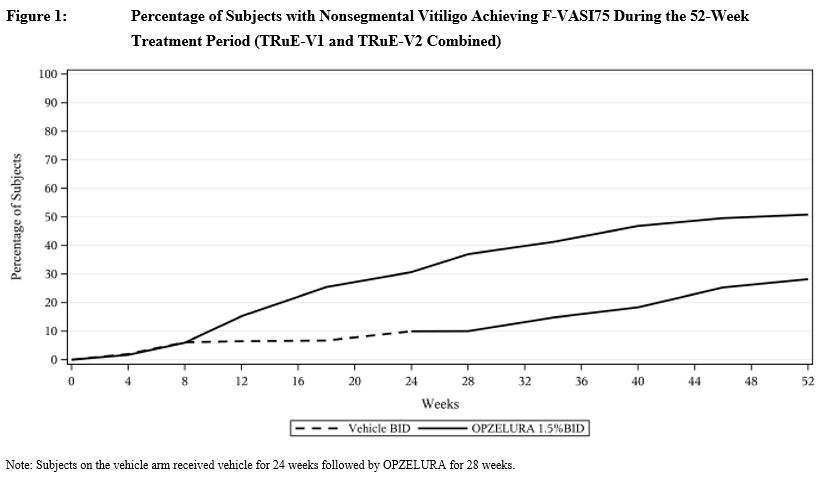
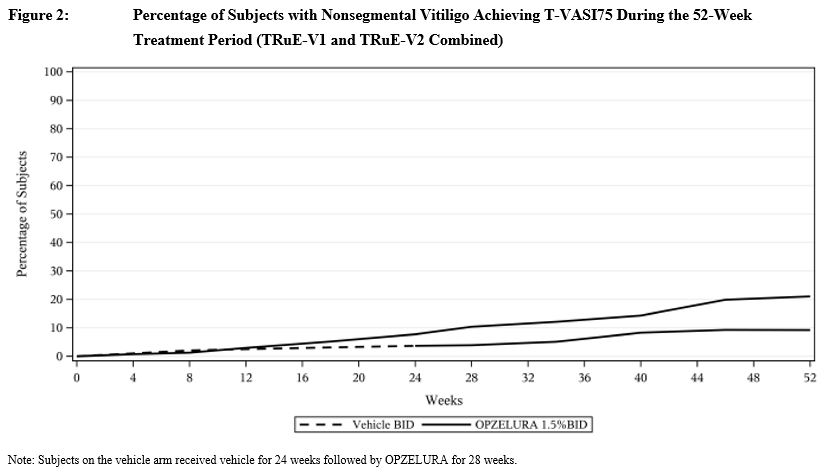
-
16 HOW SUPPLIED/STORAGE AND HANDLING
How Supplied
OPZELURA is a white to off-white cream containing 1.5% ruxolitinib and is supplied in 60 g and 100 g tubes.
60 g tube: NDC 50881-007-05
100 g tube: NDC 50881-007-07
Storage and Handling
Store OPZELURA at 20ºC to 25ºC (68ºF to 77ºF); excursions permitted from 15ºC to 30ºC (59ºF to 86ºF) [see USP Controlled Room Temperature].
-
17 PATIENT COUNSELING INFORMATION
Advise the patient or caregivers to read the FDA-approved patient labeling (Medication Guide).
Infections
Inform patients that they may be at increased risk for developing infections, including serious infections, when taking Janus kinase inhibitors. Instruct patients to tell their healthcare provider if they develop any signs or symptoms of an infection [see Warnings and Precautions (5.1)].
Advise patients that Janus kinase inhibitors increase the risk of herpes zoster, and some cases can be serious [see Warnings and Precautions (5.1)].
Malignancies and Lymphoproliferative Disorders
Inform patients that Janus kinase inhibitors may increase the risk for developing lymphomas and other malignancies including skin cancer [see Warnings and Precautions (5.3)].
Instruct patients to inform their health care provider if they have ever had any type of cancer. Inform patients that periodic skin examinations should be performed while using OPZELURA. Advise patients that exposure to sunlight, and UV light should be limited by wearing protective clothing and using a broad-spectrum sunscreen [see Warnings and Precautions (5.3)].
Major Adverse Cardiovascular Events
Advise patients that events of major adverse cardiovascular events (MACE) including non-fatal myocardial infarction, non-fatal stroke, and cardiovascular death, have been reported in clinical studies with Janus kinase inhibitors used to treat inflammatory conditions. Instruct all patients, especially current or past smokers or patients with other cardiovascular risk factors, to be alert for the development of signs and symptoms of cardiovascular events [see Warnings and Precautions (5.4)].
Thrombosis
Advise patients that events of DVT and PE have been reported in clinical studies with Janus kinase inhibitors used to treat inflammatory conditions. Instruct patients to tell their healthcare provider if they develop any signs or symptoms of a DVT or PE [see Warnings and Precautions (5.5)].
Thrombocytopenia, Anemia, and Neutropenia
Advise patients of the risk of thrombocytopenia, anemia, and neutropenia with OPZELURA. Instruct patients to tell their healthcare provider if they develop any signs or symptoms of thrombocytopenia, anemia, or neutropenia [see Warnings and Precautions (5.6)].
Administration Instructions
Advise patients or caregivers that OPZELURA is for topical use only [see Dosage and Administration (2.1)].
Advise patients to limit treatment to one 60 gram tube per week or one 100 gram tube per 2 weeks [see Dosage and Administration (2.1)].
Pregnancy Registry
Inform patients to report their pregnancy to Incyte Corporation at 1-855-463-3463 or by visiting www.opzelura.pregnancy.incyte.com [see Use in Specific Populations (8.1)].
Lactation
Advise a patient not to breastfeed during treatment with OPZELURA and for about four weeks after the last dose [see Use in Specific Populations (8.2)].
Manufactured for:
Incyte Corporation
1801 Augustine Cut-off
Wilmington, DE 19803OPZELURA is a registered trademark of Incyte. All rights reserved.
Patent Information: www.incyte.com/patents
© 2021-2024 Incyte Corporation. All rights reserved. -
MEDICATION GUIDE
MEDICATION GUIDE
OPZELURA® (OP-zuh-LUR-ah)
(ruxolitinib) CreamImportant: OPZELURA is for use on the skin only. Do not use OPZELURA in your eyes, mouth, or vagina.
What is the most important information I should know about OPZELURA?
OPZELURA may cause serious side effects, including:
-
Serious Infections. OPZELURA contains ruxolitinib. Ruxolitinib belongs to a class of medicines called Janus kinase (JAK) inhibitors. JAK inhibitors are medicines that affect your immune system. JAK inhibitors can lower the ability of your immune system to fight infections. Some people have had serious infections while taking JAK inhibitors by mouth, including tuberculosis (TB), and infections caused by bacteria, fungi, or viruses that can spread throughout the body. Some people have been hospitalized or died from these infections. Some people have had serious infections of their lungs while using OPZELURA.
- Your healthcare provider should watch you closely for signs and symptoms of TB during treatment with OPZELURA.
OPZELURA should not be used in people with an active, serious infection, including localized infections. You should not start using OPZELURA if you have any kind of infection unless your healthcare provider tells you it is okay. You may be at a higher risk of developing shingles (herpes zoster) while using OPZELURA.
Before starting OPZELURA, tell your healthcare provider if you:
- are being treated for an infection
- have had an infection that does not go away or that keeps coming back
- have diabetes, chronic lung disease, HIV, or a weak immune system
- have TB or have been in close contact with someone with TB
- have had shingles (herpes zoster)
- have or have had hepatitis B or C
- live in an area, or have lived in an area, or have traveled to certain parts of the country (such as the Ohio and Mississippi River valleys and the Southwest) where there is an increased chance for getting certain kinds of fungal infections. These infections may happen or become more severe if you use OPZELURA. Ask your healthcare provider if you do not know if you have lived in an area where these infections are common.
- think you have an infection or have symptoms of an infection such as:
- fever, sweating, or chills
- muscle aches
- cough or shortness of breath
- blood in your phlegm
- weight loss
- warm, red, or painful skin or sores on your body
- diarrhea or stomach pain
- burning when you urinate or urinating more often than usual
- feeling very tired
After starting OPZELURA, call your healthcare provider right away if you have any symptoms of an infection.
OPZELURA can make you more likely to get infections or make worse any infections that you have. If you get a serious infection, your healthcare provider may stop your treatment with OPZELURA until your infection is controlled.-
Increased risk of death due to any reason (all causes). Increased risk of death has happened in people 50 years of age and older who have at least 1 heart disease (cardiovascular) risk factor and are taking a medicine in the class of medicines called JAK inhibitors by mouth.
-
Cancer and immune system problems. OPZELURA may increase your risk of certain cancers by changing the way your immune system works.
- Lymphoma and other cancers have happened in people taking a medicine in the class of medicines called JAK inhibitors by mouth.
- People taking JAK inhibitors by mouth have a higher risk of certain cancers including lymphoma and lung cancer, especially if they are a current or past smoker.
- Some people have had skin cancers while using OPZELURA. Your healthcare provider will regularly check your skin during your treatment with OPZELURA. Limit the amount of time you spend in the sunlight. Wear protective clothing when you are in the sun and use a broad-spectrum sunscreen.
- Tell your healthcare provider if you have ever had any type of cancer.
- Increased risk of major cardiovascular events. Increased risk of major cardiovascular events such as heart attack, stroke, or death have happened in people 50 years of age and older who have at least 1 heart disease (cardiovascular) risk factor and taking a medicine in the class of medicines called JAK inhibitors by mouth, especially in current or past smokers.
Get emergency help right away if you have any symptoms of a heart attack or stroke while using OPZELURA, including:
- discomfort in the center of your chest that lasts for more than a few minutes, or that goes away and comes back
- severe tightness, pain, pressure, or heaviness in your chest, throat, neck, or jaw
- pain or discomfort in your arms, back, neck, jaw, or stomach
- shortness of breath with or without chest discomfort
- breaking out in a cold sweat
- nausea or vomiting
- feeling lightheaded
- weakness in one part or on one side of your body
- slurred speech
-
Blood clots. Blood clots in the veins of your legs (deep vein thrombosis, DVT) or lungs (pulmonary embolism, PE) can happen in some people taking OPZELURA. This may be life-threatening. Blood clots in the vein of the legs (deep vein thrombosis, DVT) and lungs (pulmonary embolism, PE) have happened more often in people who are 50 years of age and older and with at least 1 heart disease (cardiovascular) risk factor taking a medicine in the class of medicines called JAK inhibitors by mouth.
- Tell your healthcare provider if you have had blood clots in the veins of your legs or lungs in the past.
- Tell your healthcare provider right away if you have any signs and symptoms of blood clots during treatment with OPZELURA, including:
- swelling, pain, or tenderness in one or both legs
- sudden, unexplained chest or upper back pain
- shortness of breath or difficulty breathing
See “What are the possible side effects of OPZELURA?” for more information about side effects.
What is OPZELURA?
OPZELURA is a prescription medicine used on the skin (topical) for:
- short-term and non-continuous chronic treatment of mild to moderate eczema (atopic dermatitis) in non‑immunocompromised adults and children 12 years of age and older whose disease:
- is not well controlled with topical prescription therapies or
- when those therapies are not recommended
- the treatment of a type of vitiligo called nonsegmental vitiligo in adults and children 12 years of age and older.
The use of OPZELURA along with therapeutic biologics, other JAK inhibitors, or strong immunosuppressants such as azathioprine or cyclosporine is not recommended.
It is not known if OPZELURA is safe and effective in children less than 12 years of age with atopic dermatitis or nonsegmental vitiligo.
Before using OPZELURA, tell your healthcare provider about all of your medical conditions, including if you:
- See “What is the most important information I should know about OPZELURA?”
- have an infection
- are a current or past smoker
- have had a heart attack, other heart problems, or a stroke
- have or have had low white or red blood cell counts
- have high levels of fat in your blood (high cholesterol or triglycerides)
- are pregnant or plan to become pregnant. It is not known if OPZELURA will harm your unborn baby.
- Pregnancy Exposure Registry. There is a pregnancy exposure registry for individuals who use OPZELURA during pregnancy. The purpose of this registry is to collect information about the health of you and your baby. If you become exposed to OPZELURA during pregnancy, you and your healthcare provider should report exposure to Incyte Corporation at 1-855-463-3463 or by visiting www.opzelura.pregnancy.incyte.com.
- are breastfeeding or plan to breastfeed. It is not known if OPZELURA passes into your breast milk. Do not breastfeed during treatment with OPZELURA and for about 4 weeks after the last dose.
Tell your healthcare provider about all the medicines you take, including prescription and over-the-counter medicines, vitamins, and herbal supplements.
Know the medicines you take. Keep a list of them to show your healthcare provider and pharmacist when you get a new medicine.
How should I use OPZELURA?
- OPZELURA is for use on the skin only. Do not use OPZELURA in your eyes, mouth, or vagina.
- Use OPZELURA exactly as your healthcare provider tells you.
- Apply a thin layer of OPZELURA 2 times a day to affected areas. Do not use more than one 60 gram tube each week or more than one 100 gram tube every 2 weeks. Ask your healthcare provider if you have questions about applying OPZELURA.
- If you are using OPZELURA for atopic dermatitis, stop using OPZELURA when your signs and symptoms of atopic dermatitis, such as itching, rash, and redness go away, or as directed by your healthcare provider. Tell your healthcare provider if your symptoms do not improve within 8 weeks of treatment.
- If you are using OPZELURA for nonsegmental vitiligo, tell your healthcare provider if your treated skin does not improve within 24 weeks of treatment.
- Wash your hands after applying OPZELURA, unless hands are being treated. If someone else applies OPZELURA, they should wash their hands after applying OPZELURA.
What are the possible side effects of OPZELURA?
OPZELURA may cause serious side effects, including:
- See “What is the most important information I should know about OPZELURA?”
- Low blood cell counts. OPZELURA may cause low platelet counts (thrombocytopenia), low red blood cell counts (anemia), and low white blood cell counts (neutropenia). If needed, your healthcare provider will do a blood test to check your blood cell counts during your treatment with OPZELURA and may stop your treatment if signs or symptoms of low blood cell counts happen. Tell your healthcare provider right away if you develop or have worsening of any of these symptoms:
- unusual bleeding
- bruising
- tiredness
- shortness of breath
- fever
- Cholesterol increases. Cholesterol increase has happened in people when ruxolitinib is taken by mouth. Tell your healthcare provider if you have high levels of fat in your blood (high cholesterol or triglycerides).
The most common side effects of OPZELURA in people treated for atopic dermatitis include:
- common cold (nasopharyngitis)
- diarrhea
- bronchitis
- ear infection
- increase in a type of white blood cell (eosinophil) count
- hives
- inflamed hair pores (folliculitis)
- swelling of the tonsils (tonsillitis)
- runny nose (rhinorrhea)
The most common side effects of OPZELURA in people treated for nonsegmental vitiligo include:
- acne at the application site
- itching at the application site
- common cold (nasopharyngitis)
- headache
- urinary tract infection
- redness at the application site
- fever
These are not all of the possible side effects of OPZELURA. Call your doctor for medical advice about side effects. You may report side effects to FDA at 1‑800-FDA-1088.
You may also report side effects to Incyte Corporation at 1-855-463-3463.
How should I store OPZELURA? - Store OPZELURA at room temperature between 68°F to 77°F (20°C to 25°C).
General information about the safe and effective use of OPZELURA.
Medicines are sometimes prescribed for purposes other than those listed in a Medication Guide. Do not use OPZELURA for a condition for which it is not prescribed. Do not give OPZELURA to other people, even if they have the same symptoms you have. It may harm them. You can ask your pharmacist or healthcare provider for information about OPZELURA that is written for healthcare professionals.
What are the ingredients in OPZELURA?
Active ingredient: ruxolitinib phosphate
Inactive ingredients: cetyl alcohol, dimethicone 350, edetate disodium, glyceryl stearate SE, light mineral oil, medium chain triglycerides, methylparaben, phenoxyethanol, phosphoric acid, polyethylene glycol 200, polysorbate 20, propylene glycol, propylparaben, stearyl alcohol, purified water, white petrolatum, and xanthan gum.Manufactured for: Incyte Corporation, 1801 Augustine Cut-off, Wilmington, DE 19803
OPZELURA is a registered trademark of Incyte. All rights reserved.
Patent Information: www.incyte.com/patentsFor more information go to www.Opzelura.com or call 1-855-463-3463
This Medication Guide has been approved by the U.S. Food and Drug Administration. Revised: 08/2024
-
Serious Infections. OPZELURA contains ruxolitinib. Ruxolitinib belongs to a class of medicines called Janus kinase (JAK) inhibitors. JAK inhibitors are medicines that affect your immune system. JAK inhibitors can lower the ability of your immune system to fight infections. Some people have had serious infections while taking JAK inhibitors by mouth, including tuberculosis (TB), and infections caused by bacteria, fungi, or viruses that can spread throughout the body. Some people have been hospitalized or died from these infections. Some people have had serious infections of their lungs while using OPZELURA.
- 100 g Carton Label
- 100 g Tube Label
- 60 g Carton Label
- 60 g Tube Label
- 5 g Carton Label - Sample
- 5 g Tube Label - Sample
-
INGREDIENTS AND APPEARANCE
OPZELURA
ruxolitinib creamProduct Information Product Type HUMAN PRESCRIPTION DRUG Item Code (Source) NDC:50881-007 Route of Administration TOPICAL Active Ingredient/Active Moiety Ingredient Name Basis of Strength Strength RUXOLITINIB PHOSPHATE (UNII: 436LRU32H5) (RUXOLITINIB - UNII:82S8X8XX8H) RUXOLITINIB 15 mg in 1 g Inactive Ingredients Ingredient Name Strength CETYL ALCOHOL (UNII: 936JST6JCN) DIMETHICONE 350 (UNII: 2Y53S6ATLU) EDETATE DISODIUM (UNII: 7FLD91C86K) GLYCERYL STEARATE SE (UNII: FCZ5MH785I) LIGHT MINERAL OIL (UNII: N6K5787QVP) MEDIUM-CHAIN TRIGLYCERIDES (UNII: C9H2L21V7U) METHYLPARABEN (UNII: A2I8C7HI9T) PHENOXYETHANOL (UNII: HIE492ZZ3T) PHOSPHORIC ACID (UNII: E4GA8884NN) POLYETHYLENE GLYCOL 200 (UNII: R95B8J264J) POLYSORBATE 20 (UNII: 7T1F30V5YH) PROPYLENE GLYCOL (UNII: 6DC9Q167V3) PROPYLPARABEN (UNII: Z8IX2SC1OH) STEARYL ALCOHOL (UNII: 2KR89I4H1Y) WATER (UNII: 059QF0KO0R) WHITE PETROLATUM (UNII: B6E5W8RQJ4) XANTHAN GUM (UNII: TTV12P4NEE) Packaging # Item Code Package Description Marketing Start Date Marketing End Date 1 NDC:50881-007-04 1 in 1 CARTON 09/21/2021 1 5 g in 1 TUBE; Type 0: Not a Combination Product 2 NDC:50881-007-05 1 in 1 CARTON 09/21/2021 2 60 g in 1 TUBE; Type 0: Not a Combination Product 3 NDC:50881-007-07 1 in 1 CARTON 04/15/2022 3 100 g in 1 TUBE; Type 0: Not a Combination Product Marketing Information Marketing Category Application Number or Monograph Citation Marketing Start Date Marketing End Date NDA NDA215309 09/21/2021 Labeler - Incyte Corporation (556967347)

